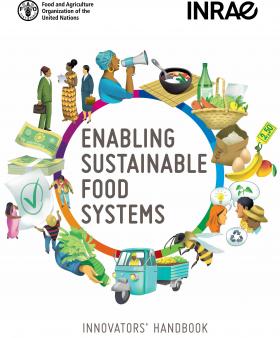FAO, INRAE and local innovators partner to build Sustainable Food Systems
Published on 13 October 2020


During the COVID-19 lockdown, consumers, producers and researchers reported increased reliance on local food systems, as long supply chains were disrupted by border closings and movement restrictions. For example, reports from Burkina Faso highlighted how the solidarity among producers and consumers living in the poorer neighborhoods of Ouagadougou ensured the sharing and exchange of food from local sources. In various locations in India the lockdown decimated supply chains, but agriculture continued showing signs of growth with creation of new localized niches in marketing. In Brazil, the Ecovida network saw a large increase in demand for their product deliveries into urban centers across three states, while in China, the community supported agriculture movement expanded their customer base.
These types of local food systems have demonstrated their resilience in times of crisis. Importantly, they are all using sustainable agriculture practices based on the 10 elements of agroecology to produce food sold in both local and territorial markets, ensuring food security and providing access to affordable healthy diets to both middle-class and marginalized communities.
Who can be a food system innovator? Just about anyone working in a food system. Our innovators are farmers, processors, public servants, municipal level officials, researchers, engineers, traders, retailers, NGOs, consumer cooperatives or simply motivated citizens.
These types of market alternatives did not just suddenly appear – they are the result of years of work by innovators who have introduced new ideas and practices into their food systems. Through the diversification of production systems and the diversification of marketing modes, these innovators have created new ways to link producers and consumers in sustainable food systems that are adaptive and are able to scale from local exchanges to territorial and even international trade.
The Handbook, available in English and French, is written for “sustainable food systems innovators” by a group of innovators from around the world who are leading initiatives to grow, share, sell and consume more sustainable foods. It includes experiences that are changing the organizational structures of local food systems and behavior of actors within to make them more sustainable. These experiences were collectively written, tested in India and Senegal and then further refined and consolidated into a user-friendly text.
A "choose your own adventure" story
The Handbook is organized as a “choose your own adventure” story where each reader – individually or in a facilitated group – can develop their own personalized learning and action journeys according to their priorities. The topics included in this handbook are arranged into four categories of innovations: engaging consumers, producing sustainably, getting products to market and getting organized.
It offers intuitive questions and guidance on where to find new ideas and techniques that worked. For example:
- Do you have a consumer base and a dedicated group of producers, but you are unable to maintain a steady supply? Read through Chapter 6: Staying connected through logistics.
- Do you want to learn about innovative pricing mechanisms like the CSA one discussed in this handbook? You can visit Chapter 3: Finding the “right” price to discover more.
- Are you interested in educational and learning approaches that go beyond school gardens? Jump to Chapter 4: Sharing and co-creating knowledge for sustainable production.
- Do you want to learn more about the market requirements that your consumers request? You can go to Chapter 2: Knowing your markets.
The Handbook is a much-needed resource in the movement towards sustainable food systems. It is being used and adapted to catalyze food system change in partner projects in Burundi, India, Morocco, Senegal, United Republic of Tanzania, and Uganda.
It is a major resource supported by the Resilient Food Systems project of the Global Environmental Facility and IFAD and the Sustainable Food Systems Programme of the One Planet Network.
